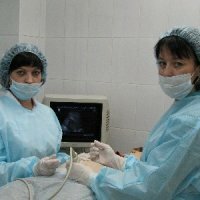Diathermocoagulation of the cervix

Cervical diathermocoagulation is an old way of destructive intrusion on the cervix. This method has been used since 1926.It is based on the use of high frequency current passing between two electrodes. Diathermocoagulation releases more heat by melting the tissues of the cervix. During the procedure, tissue coagulation occurs and the interstitial fluid evaporates. In the hearth, the temperature reaches 100 ° C.
The first electrode is called passive, usually it is large and therefore placed under the sacrum of the patient. The second electrode is called active, the tip of it is of various shapes - in the form of a loop, ball, or needle. To date, two types of this method are known - DEC and DEE( diathermocapulation and diathermic excision).Operations on the cervix by diathermocoagulation are performed immediately after menstruation is completed. The patient is recommended to abstain from sexual intercourse not only after the procedure, but before it is carried out. In the mirrors, the cervix is exposed, local anesthesia is injected, and coagulation of the affected tissues is effected and the formation of a scab is formed, which is rejected within seven to twelve days. During this period of time, the patient may experience mild bleeding.
Diathermocoagulation of the cervix is best performed immediately before menstruation, according to some information this approach is a good prophylaxis of endometriosis. The healing( epithelization) of the coagulated area usually requires 1.5-2 months, during which it is necessary to exclude sex. Use of tampons during this time to a woman is also not recommended.
This method is practically not used today, although it is aimed at removing the affected tissues, since at present there are safer and more convenient methods of treating the cervix.
- Indications for DEC
- Genital warts of the vagina and cervix
- Cervical ectopii without gross cervical dysfunction( glandular papillary pseuderosion)
- Cervical endometriosis
- Dysplasia of mild as well as moderate
This manipulation has its drawback - a high percentage of complications. Carrying out diathermocoagulation during pregnancy is unacceptable. The procedure is also not performed in the presence of inflammatory processes in the cervix and vagina, after childbirth, in the presence of invasive forms of malignant tumors.
A high percentage of complications is primarily due to the development of scar changes on the cervix, which in the future may affect the fertility condition - because of the infection of the cervical canal, a woman can develop infertility. In some cases, pathological changes lead to various complications during childbirth. Therefore, if the operation is performed in a woman of reproductive, fertile age, then such complications should be taken into account. Scarring changes are observed in 50% of patients. This method of treatment is not recommended for nulliparous women.
Bleeding is another complication that may occur after surgery. Bleeding can be very intense, mainly occurs when the scab leaves. In this case, the patient should be urgently put in a hospital and take emergency measures.
To reject necrosis better, the procedure is better performed before menstruation. In the presence of a large wound surface, a gaping of the blood vessels occurs, which often causes a profuse bleeding.
Women who have undergone diathermocoagulation should know that after the procedure the risk of endometriosis of neck localization increases. This complication negatively affects the health indicators, therefore it requires a long hormonal therapy.
Today there is an alternative to electrocoagulation - this is the method of argon-plasma ablation. This method provides a more sparing effect on the cervical tissue, and as there is no deep destruction of the tissue, there is no scarring. Therefore, this method is suitable for women who have not given birth yet.



